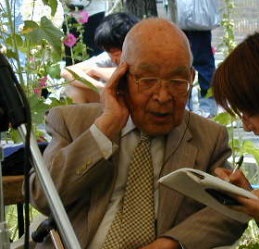BIOGRAPHY
Maruhata was born in Shimonoseki City, Yamaguchi Prefecture, Japan, on 20 December 1901, into a farming family. Reportedly, he also lived in Onomichi City, Hiroshima Prefecture.
Before World War II, he worked in an agency associated with the Ministry of Communications and Telecommunications in Tokyo. He was drafted into the military in March 1945, just before the end of the war, but his health deteriorated just before he was to go to war, and he was spared from enlistment. After World War II, he went to Hiroshima to search for his family who had been exposed to the atomic bomb and continued to live in the Ujina area.
Around 1982, he began commuting from his home on his bicycle with a hoe, plowing wasteland and planting hollyhocks to decorate the landscape along the former Japanese National Railways Ujina Line in the Ujina district where he lived. The land, which was reclaimed during the Meiji period, had poor water retention, and sunflowers and cosmos plants withered, so in the end, only hollyhocks took root in the soil. The project started with the planting of two trees and continued until about 5,000 flowers were in full bloom over about 1.2 kilometers. The street was nicknamed “Aoi Dori” by residents and became a place of relaxation for many citizens. In 1991, the “Society to Beautify the Area Along the Ujina Rinko Line” (Japanese: 宇品臨港線周辺を美しくする会) was established, led by Maruhata. In 1996, he won the Hiroshima Urban Development Design Award.
This tree-planting activity was based on his wish for foreign tourists heading into the city from Ujina Port to feel comfortable walking along the road. At the same time, his desire to decorate the site of the former Japanese National Railways Ujina Line, which served as a prewar military railway and functioned as a “road for soldiers going to war,” and to “commemorate the spirits of the heroes who were unable to return to their homeland,” was also included. Residents agreed with his idea, and the event grew to the point where an event called the Aoi no Hana Festival (Japanese: 宇品・葵の花祭り) was held. Maruhata rode a bicycle and tended flowers until he was around 100 years old, and continued to do so until he was around 104 years old.
Maruhata died in Minami Ward in Hiroshima City, Hiroshima Prefecture, Japan, on 4 October 2012, at the age of 110 years, 289 days.
RECOGNITION
At the time of his passing, he was the second-oldest living man in Hiroshima Prefecture, after Yoshio Nakagawa. He was also the fourth-oldest living man in Japan, after Jiroemon Kimura, Makaru Nakanishi, and Nakagawa.
His age was verified by Japan’s Ministry of Health, Labour, and Welfare (MHLW), as well as Ryohei Asano, and validated by LongeviQuest on 8 May 2024.
ATTRIBUTION
* Japan Elderly Registry, September 2003 issue
* E-Stat
* “葵の花祭” – Hiroshima City Ujina Elementary School, 8 June 2002
* “「英霊弔いたい」タチアオイ、今年も満開 “出征の路” 102歳の植栽“ – Sankei Shimbun, 4 June 2004

